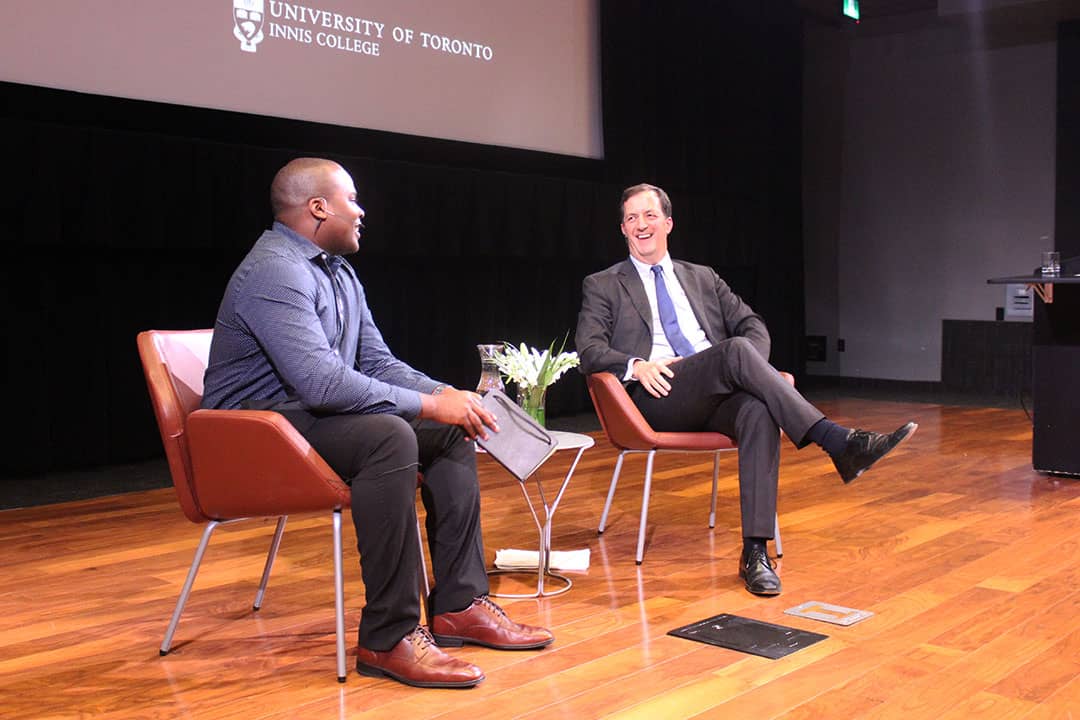Journalist and political commentator Andrew Coyne delivered the 2017 Harold Innis Lecture at Innis Town Hall on November 7. This year’s talk featured an hour-long lecture by Coyne followed by a Q&A moderated by former Varsity Managing Editor Jaren Kerr, an Innis College alumnus and Toronto Star journalist.
The annual lecture series is hosted by the Harold Innis Foundation, and it honours the work of Harold Innis, a U of T professor of political economy, contributor to the Toronto School of communications theory, and a respected author on economic history and media. Coyne, a columnist at the National Post and member of the CBC’s At Issue panel on The National, has led a career in journalism spanning over 30 years following his graduation from Trinity College in 1983. He has contributed to publications such as Maclean’s, The Globe and Mail, The New York Times, and The Wall Street Journal.
Coyne diagnosed a current crisis wherein the media, particularly existing legacy publishers, feel that their influence is declining and that they may be in “danger of disappearing altogether.”
“Once we worried the mass media had acquired too much influence, shaping our debates, our perceptions, our very ways of thinking. Now there is equal concern that the media no longer shape much of anything, and that in their weakness, something vastly worse has taken their place,” said Coyne.
Coyne stated that the media once functioned as gatekeepers, defining the matters on which reasonable people could disagree, and straddled the line between being “too narrow so as to exclude legitimate differences of opinion nor too broad so as to put crackpot theories on the same place as real knowledge.”
With the advent of the internet, advertisers up on which newspapers and other media historically relied “have deserted them en masse for Ebay and Craigslist, Facebook and Google,” leading employees at the National Post to “say we work in the non-profit sector,” joked Coyne.
Coyne was careful not to assign blame, noting that all industries “have been disrupted by the internet, and that in the end, it comes down to whether [journalists] offer a compelling enough product to attract and keep paying customers, and if we are honest with ourselves, we will concede that too often, we have not.”
As a consequence of the media crisis, fake news, most notably during the election of Donald Trump, has proliferated due to ease of access and the current climate of opinion in which there is a mistrust of experts and of professional news media.
Surpassing reasonable skepticism toward journalists and experts due to occasional error and bias, current “free-floating popular mistrust has been amplified and weaponized” by the internet’s capacity to connect once-alienated individuals and solidify their views. This has elevated mistrust to a “blind rejectionism” of media.
Subsidies to media, Coyne opined, would be an untenable solution. In a debate in Ottawa in June, Coyne said subsidies could promote mediocre reporting, making journalists “mewling supplicants for government grants,” according to the Toronto Star.
This point was challenged by The Globe and Mail’s senior media writer, Simon Houpt, during the Q&A period, who noted that “most of your career, frankly, has been spent providing content, if you will, for subsidized providers.” Coyne said that he’d spent most of his career biting the hand that feeds him.
“It seems to me to be the more hypocritical stance would be to take public subsidies and then write endless articles about why those articles should get public subsidies.”
Ultimately, the crisis entails a transformation in the media industry, primarily “from advertiser finance to reader finance”, with publications such as The New York Times, The Washington Post and The Wall Street Journal reporting “soaring subscription numbers even as they tighten their paywalls.”
Coyne suggested that media would have to rely on subscriptions to stay afloat, and referenced The New York Times’ digital subscription numbers, which totaled $83 million in revenue last quarter, whereas it received $55 million from digital advertising, a reverse of previous trends in media revenue.
“Advertisers don’t much care about quality or content. Readers, when you ask them, do,” said Coyne.
Though fewer journalists could end up working in the news business of the future, Coyne said that with readers driving content and paying for quality journalism, future journalists would be working in a healthier industry than they are today.


